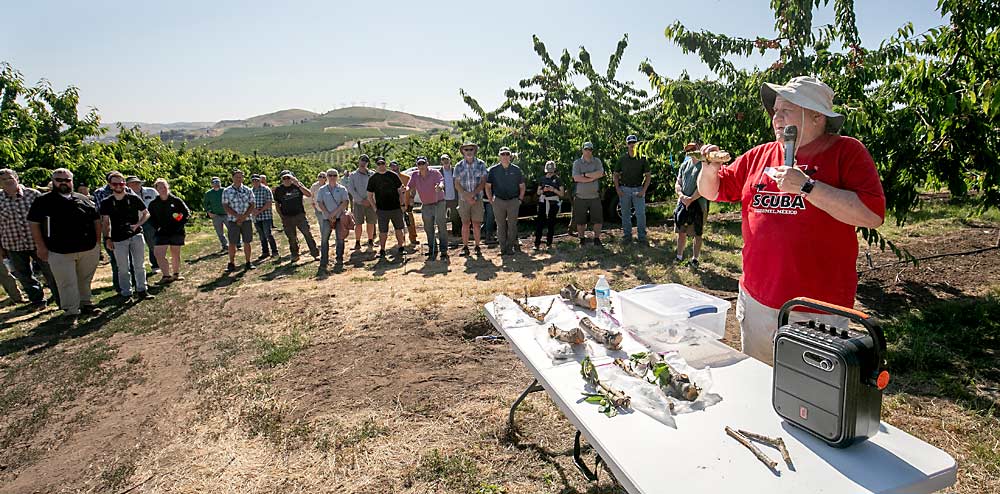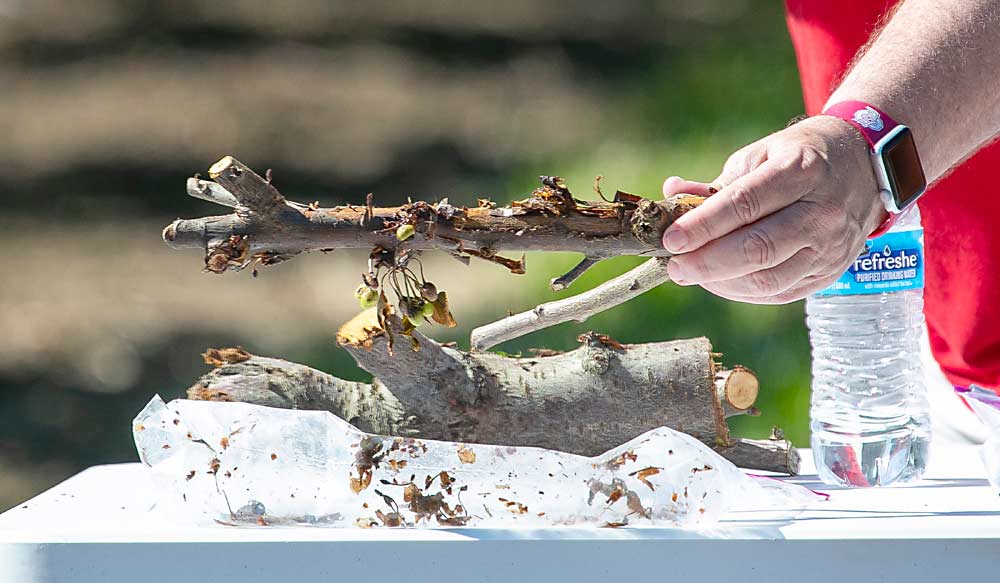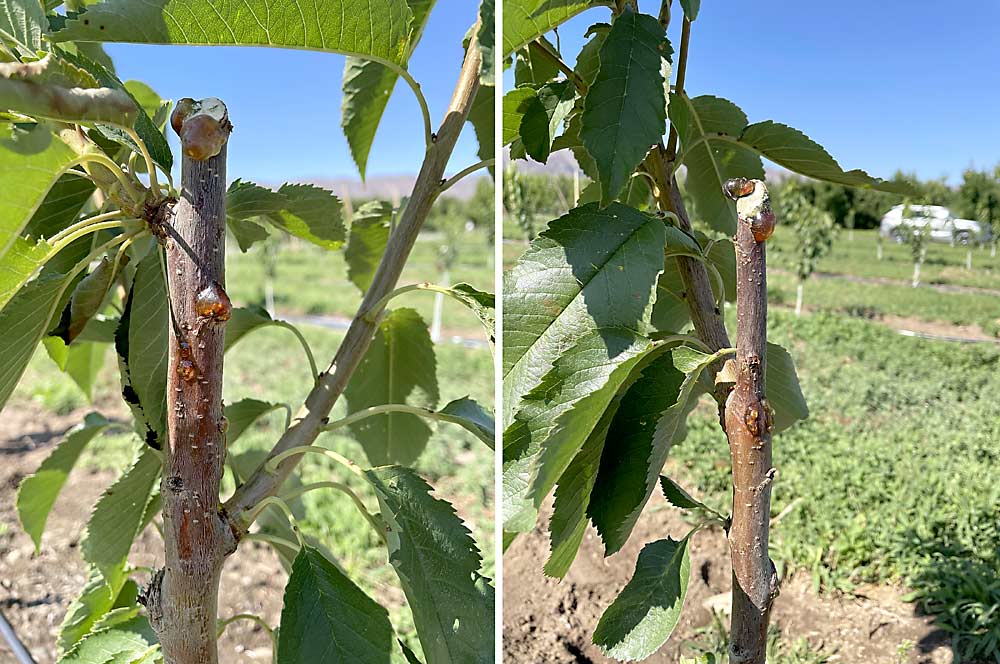
A couple of years of conducive climate conditions and mounting bactericide resistance created a welcome mat for bacterial canker in many Northwest cherry orchards.
Last year’s bacterial canker outbreak was “by far the worst I have seen in my 37 years,” said Gary Grove, a plant pathologist at Washington State University.
Grove and colleague Youfu Zhao, both based at WSU’s Irrigated Agriculture Research and Extension Center in Prosser, teamed up last year for a survey on wood-decaying fungal pathogens in cherry orchards. They found plenty of those slow-moving, canker-causing pathogens, such as Calosphearia and cytospora, but “bacterial canker is the primary problem,” Grove told members of the Washington Tree Fruit Research Commission and the Oregon Sweet Cherry Commission, which funded the research.
Moreover, the bacterial and fungal pathogens often co-occur.
“Mixed infections are the norm, not the exception,” Grove said.
Symptoms of bacterial canker include cankers, amber-colored gummosis and dieback of girdled branches.

Zhao analyzed samples from 57 orchards last year, looking for the bacterial canker pathogen, Pseudomonas syringae, and collecting samples to evaluate for resistance. And he found it for growers’ main tools: coppers and kasugamycin.
The current data show widespread copper resistance, and several of the strains he collected even showed resistance to both, Zhao said in a talk at the Cherry Institute in January. Resistance to coppers has been reported in Oregon as well, but the evidence of kasugamycin resistance is new.
“Based on these observations in the field, we need to minimize the damage of this disease” with cultural practices, he said.
If growers have copper-resistant strains of the bacteria in their orchards, spraying those products will only exacerbate the problem, Zhao said. Growers who suspect resistance can contact him to learn more about how to collect samples for analysis, he added.
He also identified two subspecies of P. syringae: the Northwest’s usual suspect, Pseudomonas syringae pv. syringae and a new detection for the region, P. syringae pv. morsprunorum.
“So, it’s more complicated than we thought,” he said, though there’s no indication the newly detected subspecies is somehow worse.
But for growers, he focused on the fundamentals: The Pseudomonas bacteria overwinters in cankers and buds, and infections can spread through wounds during cold, wet conditions in the spring and fall. Rain or irrigation splashes move the bacteria around, and it can survive a long time on plant surfaces, including weeds. Later in the season, it can infect leaves and fruit as well, though that is rare in the Northwest’s hot summers.
Remember the long, warm fall of 2022, when many trees failed to harden off before a hard November freeze? That likely created plenty of wounds for the Psuedomonas to colonize during the long, wet spring of 2023. That high disease pressure left plenty of inoculum pressure going into this season.
The No. 1 strategy to avoid infection?
“Prune only when the weather is dry,” Zhao said. He recommended summer pruning when possible and switching from sprinklers to drip to keep the orchard environment drier.
Young trees face the most risk. In larger trees, the cankers can be cut out, Zhao said, but that’s fatal for young trees.

Winter pruning — if conditions are dry — should be OK, said WSU Extension specialist Bernardita Sallato, but she echoed the risk facing new plantings.
“What we know is that when we are planting new orchards, we do heading cuts to start training,” creating a large wound during susceptible weather conditions, she said. “That’s where we get a lot of infecting of the trees.”
Similarly, scoring to induce bud break in the spring occurs at a risky time. Plan around the weather and postpone irrigation if possible, she said.
Zhao also recommended painting trunks white to prevent winter injury; avoiding paper grow tubes, which can create a moist habitat for bacteria; and planting healthy trees.
Infection can also occur in the fall: As temperatures and leaves drop, the leaf scars can be infected. Forcing the leaves to drop earlier in the fall with chemical treatments may reduce the risk, Sallato said. In her own trials, urea and plant growth regulator abscisic acid (ABA) induced early defoliation in early October, with little negative consequence on yield the following season. But, she has not evaluated the approach for disease control.
Late rainy weather in November and December — as happened last year — would also pose a risk for dormant pruning, said Garrett Bishop of G.S. Long Co.
“If you can delay until January or February, when it’s colder, you are in a much better scenario,” he said. “You need to make sure you are managing your fertility and irrigation for shutting down the trees, so things can harden off enough that you don’t get winter damage from fall freezes.”
While stone fruit growers are certainly familiar with bacterial canker, the recent pressure caught some people off guard. Bishop blames a combination of the conducive weather and the popularity of newer varieties that are more susceptible, such as Coral Champagne and Black Pearl.
“That’s a new curveball,” he said.
He recommends keeping block risk in mind as growers balance pruning needs with risky weather.
“You can’t always wait for the perfect timing to prune, based on weather, but at least in your younger blocks, your Coral Champagne blocks, try to do those at the optimum timing,” Bishop said. “Your older Chelans and Bings can get pruned in those less ideal time periods.”
Bishop, like Zhao and Sallato, stressed the importance of cultural practices in the face of resistance development.
It’s not easy, but careful management can keep the disease in check, Zhao said.
“If you take good care of the orchard, it should be fine,” he said. “It’s not fire blight.”
—by Kate Prengaman






Leave A Comment